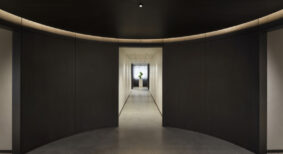Municipalities constantly face the challenge of delivering high quality services to their communities. The delivery of many of these services requires state-of-the-art facilities such as community centres that meet today’s needs while anticipating those of the future.
Each community centre is an opportunity to add another “piece of urban fabric that should represent and be characteristic of the community it’s being developed for,” according to architect Walter Francl.
Francl was one of four panelists speaking at a session called “Creating great community facilities – from the municipal perspective” during Buildex Vancouver 2017. He highlighted a few different innovative facilities which have become important gathering places for their respective neighbourhoods including Creekside Community Centre and Wesbrook Community Centre.
The City of Vancouver and the City of Surrey are two leading municipalities that have different issues when it comes to community facilities. Vancouver has many old buildings from the 50s as well as exciting new ones, while Surrey is one of the fastest growing cities in North America so they have different issues to deal with, according to Danica Djurkovic, Vancouver’s director of facility planning and development.
Djurkovic began by talking about the history of communities and how community facilities reflect society which still “rings true today.”
“We can get a solid picture of our society by looking at community facilities… the level of engagement and commitment to community facilities tells a story even today,” she said.
At the City of Vancouver, there is a sense of accountability and responsibility to play a leadership role and lead by example, continued Djurkovic, citing as an example of how the city tests codes on their own buildings before implementing them for the private sector.
The city owns 650 buildings in Vancouver and 465 of them are community facilities, she said, and many of them inherited from the 50s are neighbourhood based. The city uses a robust database and program for asset management.
“We have excellent sense of the conditions of our buildings,” she said, adding the database is used to inform “future decisions on renewal, renovation or disposition of properties.”
Scott Groves, manager of civic facilities for the City of Surrey, said the municipality was known as a suburb where people commute in and out of, but now the goal is to transform into a vibrant city. That transformation is starting with a new city centre that is “much larger than Vancouver.”
Surrey has a huge land base, as large as Vancouver, Burnaby and Richmond combined, noted Groves, and population growth is happening south of the Fraser Valley in Surrey and Langley. “We have 1,000 people a month moving into the city,” he said.
Groves highlighted the new city hall which was moved to the geographic centre of the city to act as a catalyst for new development such as the City Centre Library.
A recent project he is very proud of is the Grandview Heights Aquatic Centre, a community hub that was built “before the community got there.” Grove explained the building will act as an anchor for the new community.
The Aquatic Centre delivers “world class architecture” but looking great isn’t enough, it must also be a place where people want to be and use, stressed Groves. And the centre has been successful that way, with 3,000 people using the facility daily last summer.
The next project for Surrey is developing the Clayton Community Hub, which will integrate a library, arts, recreation and outdoor spaces in a single facility. “The community is one of our fastest growing and it doesn’t have a heart,” said Groves. “Creating a community facility, it changes society. That’s our goal on this one.”
Darryl Condon, managing partner at HCMA Architecture + Design, discussed the design process and strategies for Clayton facility. “We are trying to create a new model – new hybrid where it’s integrated into a much higher level so we need to think differently,” he said.
Diverse stakeholders within Surrey were brought together to brainstorm ideas to develop a set of values and principles that could bind the project together even before design started. Dynamic and creative means were used to engage people and encourage them to participate, said Condon. They held an “ideas fair” to gain input from the public.
The overriding message from the community was they were “desperate for hang out space” and collaborative and friendly environments. Condon said these are not unique themes but they are prevalent in creating great community facilities.
Cheryl Mah is managing editor of Design Quarterly







